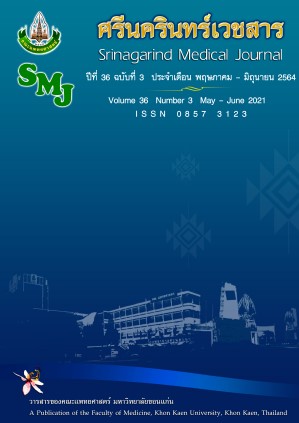Prevalence and Factors Associated with Metabolic Syndrome at Health Promoting Hospital, Khon Kaen
Keywords:
Metabolic Syndrome; Prevalence; BMI; Associated factorsAbstract
Objective: Metabolic syndrome is one of the most important causes of cardiovascular and cerebrovascular diseases. Nowadays, the global prevalence of metabolic syndrome has been increased. The authors aimed to study the prevalence and the associated factors of metabolic syndrome in Health Promoting hospital, Regional health promotion center 7, Khonkaen.
Method: This was an analytical cross-sectional study, A convenience sample composed of 302 persons who came for check up at health promotion clinic, in health promoting hospital, Regional health promotion center 7, during 15 January - 15 March 2021. Metabolic syndrome was diagnosed by using modified NCEP ATP III 2005 criteria. The prevalence of metabolic syndrome was calculated. The significant health factors related to metabolic syndrome were analyzed, using 2-sided Chi-square and logistic regression analysis.
Results: The overall prevalence of metabolic syndrome was 32.78 % (23.71% in men, 25.66 % in women who age< 60 years and 52.94% in men, 50% in women who age >60 years). Factors that were significantly related to metabolic syndrome were age, body mass index, smoking, physical activity, and familial history of dyslipidemia.
Conclusion: Nearly one-third of the population in our study had metabolic syndrome. It is important to find the related factors that should be mainly focused to modify and prevent the metabolic syndrome.
References
2. Tran BT, Jeong BY, Oh JK. The prevalence trend of metabolic syndrome and its components and risk factors in Korean adults: results from the Korean National Health and Nutrition Examination Survey 2008–2013. BMC Public Health 2017; 17(1): 71.
3. Hirode G, Wong RJ. Trends in the prevalence of metabolic syndrome in the United States, 2011-2016. JAMA 2020; 323(24): 2526–2528.
4. Laaksonen DE, Lakka H-M, Niskanen LK, Kaplan GA, Salonen JT, Lakka TA. Metabolic syndrome and development of diabetes mellitus: application and validation of recently suggested definitions of the metabolic syndrome in a prospective cohort study. Am J Epidemiol 2002; 156(11): 1070–1077.
5. Isomaa B, Almgren P, Tuomi T, Forsén B, Lahti K, Nissén M, et al. Cardiovascular morbidity and mortality associated with the metabolic syndrome. Diabetes Care 2001; 24(4): 683–689.
6. Lakka H-M. The metabolic syndrome and total and cardiovascular disease mortality in middle-aged men. JAMA 2002; 288(21): 2709.
7. Chen HJ, Bai CH, Yeh WT, Chiu HC, Pan WH. Influence of metabolic syndrome and general obesity on the risk of ischemic stroke. Stroke 2006; 37(4): 1060–1064.
8. Pannipa Boontein, Bongkot Anuritprasert, Chongjit Saneha Factors related to Metabolic Syndrome among Patients at Out-Patient Department. J Nurs Sci 2017; 35: 74–86.
9. Sermsak Patipan .. Prevalence and Risk Factor Metabolic Syndrome of Employees Who Work in Shifts in an Electric Component Factory in Nakhon Ratchasima. Nursing Journal of the Ministry of Public Health 2015; 25: 156–165.
10. Aekplakorn W, Chongsuvivatwong V, Tatsanavivat P, Suriyawongpaisal P. Prevalence of metabolic syndrome defined by the international diabetes federation and national cholesterol education program criteria among Thai adults. Asia Pac J Public Health 2011; 23(5): 792–800.
11. Grundy SM, Cleeman JI, Daniels SR, Donato KA, Eckel RH, Franklin BA, et al. Diagnosis and management of the metabolic syndrome: an American Heart Association/National Heart, Lung, and Blood Institute Scientific Statement. Circulation 2005; 112(17): 2735–2752.
12. Yuenyongchaiwat K, Pipatsitipon D, Sangprasert P. The prevalence and risk factors of metabolic syndrome a suburban community in Pathum Thani province, Thailand. Songklanakarin J Sci Technol 2017; 39: 787–792.
13. Thai CV risk score [Internet]. [cited 2021 Feb 5]. Available from: https://med.mahidol.ac.th/cardio_vascular_risk/thai_cv_risk_score/
14. NCDs | Global Physical Activity Surveillance [Internet]. WHO. World Health Organization; [cited Feb 3, 2021]. Available from: http://www.who.int/ncds/surveillance/steps/GPAQ/en/
15. Ravikiran M, Bhansali A, Ravikumar P, Bhansali S, Dutta P, Thakur JS, et al. Prevalence and risk factors of metabolic syndrome among Asian Indians: a community survey. Diabetes Res Clin Pract 2010; 89(2): 181–188.
16. Sigit FS, Tahapary DL, Trompet S, Sartono E, Willems van Dijk K, Rosendaal FR, et al. The prevalence of metabolic syndrome and its association with body fat distribution in middle-aged individuals from Indonesia and the Netherlands: a cross-sectional analysis of two population-based studies. Diabetol Metab Syndr 2020; 12(1): 2.
17. Podang J, Sritara P, Narksawat K. Prevalence and factors associated with metabolic syndrome among a group of Thai working population: a cross sectional study. J Med Assoc Thail 2003; 96 Suppl 5:33-41.
18. Pongchaiyakul C, Nguyen TV, Wanothayaroj E, Karusan N, Klungboonkrong V. Prevalence of metabolic syndrome and its relationship to weight in the Thai population. J Med Assoc Thail 2007; 90(3): 459–467.
19. Ford ES. Prevalence of the metabolic syndrome in US populations. Endocrinol Metab Clin North Am 2004; 33(2): 333–350.




